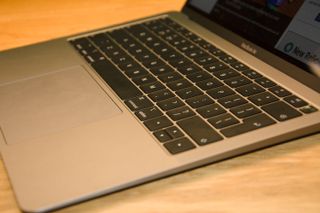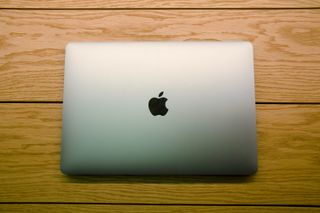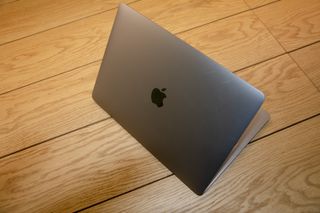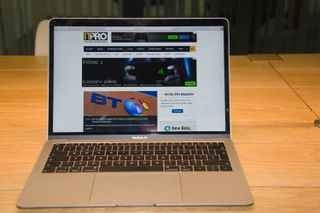IT Pro Verdict
This year’s MacBook Air won’t blow you away with its performance, but it will light up your eyes with its masterful design and overall user experience.
Pros
- +
Beautiful Retina display; Superb keyboard; Visually stunning design
Cons
- -
Lacklustre battery life under load; Performance doesn’t stack up to rivals in its field
Ten years after the first MacBook Air made its debut, Apple has unveiled a major update to its iconic ultraportable laptop. It’s still super-slim and gorgeously shiny, but the 2018 model features numerous improvements on the old design that keep it at the cutting edge of desirability.
While the new Air certainly looks fresh, however, the rest of the market has been evolving too. The question is, then, how does the latest MacBook Air stack up against today’s competition?
Apple MacBook Air (2018) review: Design
The 2018 MacBook Air is unmistakably an Apple laptop, but it’s not quite like any model that’s come before. It sports a brand new chassis, keyboard and screen, and it’s even thinner than previous models, measuring 15.6mm thick at its widest point, versus the 17mm thickness of the old Air.
It’s lighter too, weighing in at just 1.25kg, down from 1.35kg; that means it’s a tad heavier than either the Dell XPS 13 or the Lenovo ThinkPad X1 Carbon, but it’s still deliciously portable – you can happily tuck it under an arm and hop from meeting to meeting without feeling like you’re lugging a piece of hardware around.

There’s a new choice of colours as well. The 2018 MacBook Air can be had with the familiar matte aluminium finish, or in gold, silver or Space Grey colour schemes. We tested the latter, which looks suitably professional, and tones nicely with the dark grey keyboard, though for those seeking a bit more pizzazz, the design works just as well in the more glamorous colours.
Apple MacBook Air (2018) review: Keyboard and trackpad
Like all modern Mac laptops, the new MacBook Air uses a low-profile butterfly keyboard. It’s been suggested that this design can be prone to hardware problems, but we had no problem with it at all – in fact, it’s one of our favourite features of the laptop. We found the keys were the perfect size, with a supremely satisfying sound and action and bright, even backlighting.
The trackpad meanwhile now supports Force Touch, which allows you to press down firmly to access operations such as renaming files or searching the web for a selected term. In practice we found ourselves rarely making use of it, and indeed we found it irritating when we accidentally clicked too hard, causing the built-in macOS dictionary app to pop up in a new window. We can see it being useful in certain situations, however, and if you don’t use it then you can always turn the feature off.
Needless to say, the pad also retains the multi-touch functionality of previous models, and this still works brilliantly. Using two fingers to scroll up and down through windows and web pages instantly feels natural, while a three-finger swipe makes switching between apps a breeze. You can work happily on this laptop all day without ever feeling the need to attach an external mouse.
Apple MacBook Air (2018) review: Display
One of the most significant upgrades in the 2018 MacBook Air is the new display. Previous 13in models had chunky metal bezels and a mediocre resolution of 1,440 x 900, but here the surrounds have been drastically slimmed down and the old panel has been replaced with a 2,560 x 1,600 Retina screen. The result is a striking, ultra-sharp visual experience that blows the last-generation MacBook Air away.

That’s not the only improvement, either. Apple claims the screen has significantly better colour reproduction, and our own tests bear that out: the 2018 MacBook Air covered a respectable 93.2% of the sRGB gamut, while the Dell XPS 13 only managed 90.2%.
Simply put, it’s a fantastic screen. The one area where the MacBook Air’s display doesn’t stand out is brightness: its peak of 315cd/m² is some way behind the XPS 13 and Lenovo’s ThinkPad X1 Carbon, which managed 454cd/m2 and a dazzling 527cd/m2 respectively. Don’t worry about that too much, though, as it certainly doesn’t look dim: you’ll have no problem reading the screen even in direct sunlight.
Apple MacBook Air (2018) review: Specs and hardware
Among many upgrades under the bonnet, one notable new feature is one you won't need a screwdriver to have a look at. Touch ID has been a big selling point for iPhones and iPads for years, even featuring on more recent MacBook Pro models too, but this is the first time you'll be able to use it to unlock your MacBook Air. Replacing the traditional power button in the top right corner of the keyboard sits a small, square-shaped tile which, when tapped, unlocks the system, replacing the common password. It even works better than with any iPhone we've used - we've never had a failed read, which is a welcome surprise considering how unpredictable the iPhone's reader can be.
The new Air features a new Intel Core i5 CPU, an 8th-generation chip as opposed to the 5th-generation model which powered its predecessor. On the face of things, one might expect the chip with three generations of development in it to be much faster than an older version, but there has only been a marginal increase in the turbo boost clock speed to the tune of 0.4GHz.
Just like the previous model, the new Air is still using a dual-core i5 chip, but instead of a U-series part, the new laptop is using a Y-series Amber Lake CPU.Y-series chips have a lower base clock speed than the U-series processors used in past models, and they also have a lower Thermal Design Power (TDP) than U-series CPUs, which makes them more power efficient but also less powerful.
We tested the 8GB RAM model, but it has the option to go up to 16GB. The graphics upgrade from the Intel HD Graphics 6000 to the Intel UHD 617 was also much needed to support the new stunning Retina display.

Other than the serious upgrades, the new model also has a slightly newer version of Bluetooth, the aforementioned Force Touch trackpad and two USB-C ports which we'll talk about in more detail later on. Overall, the hardware upgrades are sufficient enough to warrant the term 'upgrade' but if it's strictly performance you're looking at, you may be better off shelling out a bit more for the MacBook Pro.
Apple MacBook Air (2018) review: Performance
Specifications aside, the Air felt just about good enough for work use. During our time with it, we used it with multiple browsers open as well as other programs such as Slack, Spotify and Notes. It performed well most of the time, but at other points, it started to struggle. Periods of sluggishness happened infrequently at first but soon started to become more regular and ultimately more infuriating.
During these periods, instances of switching between windows weren't lightning-quick and sometimes there was a short input delay between pressing a key and it appearing on the web page. This sluggishness was short-lived before normal service was resumed, but it was noticeable nonetheless.
When it's working well, which was most of the time, it's a beautiful machine and the experience is fluid and enjoyable, but the occasional bout of poor performance, which after a few days of using become more noticeable, really damaged our overall opinion of the Air. At times we wished we had something else to work with.
Its speed issues were underlined by the fact that it was outperformed by two of its main competitors in our benchmark tests. The XPS 13 and X1 Carbon both scored better in our Geekbench and graphics tests with significantly higher FPS scores as well as longer battery life.
The Air scored 7,892 in the Geekbench 4 64-bit multi-core test while the XPS 13 scored nearly double with 15,047 and the ThinkPad X1 Carbon falling just behind that with 14,593. The new Intel UHD graphics didn't do much to help its cause either, scoring a miserable 10.2 FPS in the GFXBench Car Chase onscreen test. The ThinkPad scored noticeably higher with 16.4 FPS and the XPS blew the competition out of the water with 31.9.
With our own 4K media benchmark tests, the Air scored poorly, especially compared to its competitors. It scored a lacklustre 49 while for comparison, the XPS 13 scored an excellent 96 while the ThinkPad X1 Carbon scored 80. This means it will work just fine for typing up a report or preparing a presentation - just don't expect to have much luck with anything more taxing.
Apple MacBook Air (2018) review: Battery life
To be considered a decent ultrabook, the Air would have to deliver on a few things, one of which is battery life. It's only worthwhile having something so portable if it can still work for a reasonable duration while on the move.

During our benchmark tests, it scored a respectable 8hrs and 34mins, edging out the ThinkPad by around an hour, but nowhere near the XPS 13's score of over 10 hours.
The story took a dramatic turn when we actually got our hands on it, however. In all fairness, we really ramped up the battery-draining features to the max during testing: screen brightness was at its highest, as was the backlit keyboard, AirPods connected via Bluetooth and playing music, not to mention the myriad programs and processes that are involved in a normal work day but despite all this, we expected much more than we got.
On a full charge, tested on two separate occasions, we got a miserable average of around five hours' worth of battery life during everyday work use. This will fluctuate depending on what you use the machine for - casual users will get much more than power-users, for example - but you'd be running on fumes if you wanted to use it on the train from London to Edinburgh, or just from lunch until you clock off.
Apple claims it has up to a 12-hour battery life which increases to 13 hours if you just want to watch movies continuously, seemingly perfect for a transatlantic flight. These claims don't seem to hold true as this is the same metric with which we run our battery benchmarks and we experienced a battery life four hours shorter than Apple promised. If you're looking for something with more battery power to use for more demanding tasks, go elsewhere.
Apple MacBook Air (2018) review: Ports and features
Much to the dismay of those who use peripherals, the MagSafe power port, USB 3 ports, Thunderbolt 2 port and SDXC card slot have all been purged in favour of just two USB-C ports (which also support Thunderbolt 3) and a 3.5mm headphone jack. This shaves some millimetres off the chassis, at the expense of connectivity options.
The sides of the device look a little bare now, but thanks to the USB-C connection, you won't need a vast array of ports anyway. It's slowly making its way to more and more devices now, but USB-C is an absolute game-changer for the peripheral world. Capable of connecting a keyboard, mouse, external displays and storage, all while charging the device using one cable? As 2018 draws to a close, it should be criminal to release anything without it (we're looking at you, Microsoft).
Apple MacBook Air (2018) review: Verdict

For a laptop that has so much visual appeal, we really hoped that we would be as mesmerised by its performance as we are by its design. Sadly, we could not be distracted from the short-lived battery and sporadically lagging performance. When compared to similar devices at the same level, MacBook comes off unjustifiably pricey. In fact, you might be better off by getting the Dell XPS 13 and saving £300.
On the other hand, it is worth emphasising that the new MacBook's design will sweep you off your feet. Apple has truly rolled out the best upgrades when it comes to display and keyboard design. Looks are not everything, but it must be said that this is probably the most stunning ultrabooks we've ever tested. For that reason, if you are a fan of Apple and thrive when using MacOS, it might be worth turning a blind eye on the sporadic performance issues - just remember to keep a charger at hand!
Verdict
The 2018 MacBook Air is probably not worth its expensive price tag, due to its overall performance and battery life, but it will make you fall in love with its impeccable minimalist design and its generally positive user experience.
| Processor | Dual-core Intel Core-i5 8510Y (1.6GHz) |
| RAM | 8GB |
| Additional memory slots | 0 |
| Max. memory | N/A |
| Screen size | 13.3in |
| Screen resolution | 2,560 x 1,600 |
| Pixel density | 227ppi |
| Screen type | IPS |
| Touchscreen | No |
| Pointing devices | Touchpad |
| Graphics adapter | Intel UHD Graphics 615 |
| Graphics outputs | USB Type-C |
| Graphics memory | 1.5GB |
| Storage | 256GB |
| Optical drive | None |
| Memory card slot | None |
| USB ports | 2 x USB Type-C (Thunderbolt 3) |
| Other ports | None |
| Web Cam | 720p FaceTime HD |
| Speakers | Stero |
| 3.5mm headphone jack | Yes |
| Wi-Fi | 802.11ac |
| Bluetooth | 4.2 |
| NFC | No |
| Dimensions (WDH) | 304 x 212 x 4.1-15.6mm |
| Weight | 1.25kg |
| Operating system | MacOS Mojave |
| Operating system restore option | N/A |
| Battery size | 50Wh |

Connor Jones has been at the forefront of global cyber security news coverage for the past few years, breaking developments on major stories such as LockBit’s ransomware attack on Royal Mail International, and many others. He has also made sporadic appearances on the ITPro Podcast discussing topics from home desk setups all the way to hacking systems using prosthetic limbs. He has a master’s degree in Magazine Journalism from the University of Sheffield, and has previously written for the likes of Red Bull Esports and UNILAD tech during his career that started in 2015.
